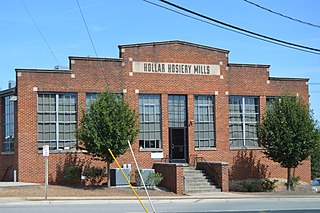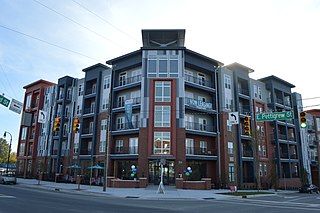
Winston-Salem is a city in and the county seat of Forsyth County, North Carolina, United States. At the 2020 census, the population was 249,545, making it the fifth-most populous city in North Carolina and the 91st-most populous city in the United States. The population of the Winston-Salem metropolitan area was estimated to be 695,630 in 2023. It is the second-most populous city in North Carolina's Piedmont Triad region, home to about 1.7 million residents.

Hanes and Hanes Her Way is a brand of clothing.

John Wesley Hanes was an American businessman from Winston-Salem, North Carolina who ran a tobacco company before founding Shamrock Mills in 1901, the company that became Hanes Hosiery Mills.

The Avondale Mill Historic District is a former mill village in Pell City, Alabama. Part of the Avondale Mills, the area is architecturally significant for the first sawtooth roofed mill in Alabama, and the mill village represents a relatively intact example of an early 20th century company town. The mill and its village were listed on the National Register of Historic Places in 2000. The mill closed in 2006, and burned in 2008 while being dismantled for scrap.

Mock, Judson, Voehringer Company Hosiery Mill, also known as MoJud Hosiery Company and Rolane Factory Outlet Store, is a former hosiery production plant located at 2610 Oakland Avenue in Greensboro, Guilford County, North Carolina. The company was founded in 1926, and operated until 1972. The plant was then shut down, except for a small portion used as an outlet store, until its final complete shutdown in 1999. The plant was listed on the National Register of Historic Places in 2011.
Durham Hosiery Mill No. 15, also known as Mebane Yarn Mills, Inc. and Rockfish-Mebane Yarn Mills, Inc., is a historic hosiery mill building located at Mebane, Alamance County, North Carolina. It was built in 1922, and is a two-story, 20-bay, cast-in-place concrete mill building. Two-story concrete pilasters define each window bay. It features a centrally-placed, two-story, projecting square tower. A nine bay addition was built in 1966. The mill closed in 2001.

Garrou-Morganton Full-Fashioned Hosiery Mills, also known as Premier Hosiery Mills and Morgantown Hosiery Mills, is a historic hosiery mill complex located at Morganton, Burke County, North Carolina. The complex encompasses three contributing buildings and one contributing structure. They are the two Art Moderne style main buildings ; Outlet Store (1924) and Water Tower Structure.

Hollar Hosiery Mills-Knit Sox Knitting Mills is a historic knitting mill located at Hickory, Catawba County, North Carolina. It consists of two mill brick manufacturing buildings and a boiler house that were connected by a hyphen in the mid-1960s. The first mill building was built about 1930, and is a one- to two-story, 16 bay, brick veneer structure. The boiler house was also built about 1930, and is a small, brick building, with its flat roof and terra cotta coping. The hosiery yarn mill was built about 1940, and is two-story, six bay by 10 bay, brick-veneered building. Both mill buildings feature banks of steel-sash factory windows. The knitting mill operated until 1968.

Whisnant Hosiery Mills, also known as Moretz Mills, is a historic knitting mill located at Hickory, Catawba County, North Carolina. It is a one- to two-story, trapezoidal shaped brick building consisting of contiguous sections built in 1929, 1937, the 1940s, the 1950s, and 1966. The mill closed in 2011. It was listed on the National Register of Historic Places in 2013. The property underwent significant rehabilitation using historic tax credits and re-opened as a mixed use space in April 2015. The property was designated a local historic landmark by the City of Hickory in August 2015.

Mor-Val Hosiery Mill, also known as Morris Mill, is a historic textile mill located at Denton, Davidson County, North Carolina. It was built in 1936, and is a one-story brick building consisting of a manufacturing area and office wing. It has a low-pitched roof and oversized windows. The mill remained in operation until about 1965.

Durham Hosiery Mill is a historic textile mill complex located at Durham, Durham County, North Carolina. It includes seven contributing brick buildings in the complex. The original Durham Hosiery Mill was built in 1902, and consists of a four-story main building with a six-story Romanesque Revival-style tower in front; engine, boiler, and heater houses attached at the rear, and a one-story dye house. The main building was expanded with a two-story annex in 1904, and a three-story annex in 1906. Other buildings include the triangular Annex No. 1 (1912) and a three-story brick finishing building. By 1910, the Durham Hosiery Mills Corporation was the largest manufacturer of cotton hosiery in the world. The mill was abandoned in 1922.

Durham Hosiery Mills No. 2–Service Printing Company Building was a historic textile mill building located at Durham, Durham County, North Carolina. It was the remaining section of a one-story brick building constructed by the Durham Hosiery Mills Corporation in 1916. The other section was destroyed by a fire in 1979. It featured tall segmental arched windows, heavy exposed curved rafter ends in the eaves, and a monitor roof. After 1947, it housed the Service Printing Company.

Durham Hosiery Mills Dye House is a historic textile mill building located at Durham, Durham County, North Carolina. It was constructed by the Durham Hosiery Mills Corporation in three sections between 1920 and 1921. They are the boiler room, office / warehouse, and dyeing area. It is constructed of exterior reinforced concrete bearing walls, steel trusses and a heavy timber structural system.

P.H. Hanes Knitting Company is a historic textile mill complex located at Winston-Salem, Forsyth County, North Carolina. The complex includes three buildings. The Knitting Building or North Building was built in 1920–1921, and is a six-story, Beaux-Arts-style concrete and steel building sheathed in brick. The Mill Building or East Building was built in 1928, and is a five-story-plus-basement building of concrete, brick, and steel construction. The Warehouse and Shipping Building was built in 1940, and is a six-story steel frame building sheathed in brick. The P.H. Hanes Knitting Company was founded in 1901 by Pleasant H. Hanes, brother of John W. Hanes who founded Shamrock Mills, later Hanes Hosiery. In February 1965, P. H. Hanes Knitting Company merged with Hanes Hosiery. The downtown mill complex closed in 1965. The complex has been converted to loft apartments.
Belmont Hosiery Mill was a historic textile mill building located at Belmont, Gaston County, North Carolina. The original section was built in 1945–1946, and was a two-story-on-basement brick mill building. In 1952, a two-bay-deep, two-story-on basement addition was built and in 1958, a two-story-on-basement rectangular addition was built and features Art Moderne detailing. In 1969, a roughly U-shaped two-story-on-basement addition was built at the rear of the mill. A small one-story loading dock addition completed around 1998. The mill closed in 2000. The mill has been demolished.

Grey Hosiery Mill, also known as Water Department-City of Hendersonville and Hold Hosiery, is a historic textile mill located at Hendersonville, Henderson County, North Carolina. It was built in 1915, with additions in 1919 and 1947. It is a one-story, brick building with large multi-pane steel sash windows and stepped gable roof with clerestory. The mill closed in 1967.

Asheboro Hosiery Mills and Cranford Furniture Company Complex, also known as Cranford Industries and National Chair Company, is a historic textile mill and furniture factory complex located at Asheboro, Randolph County, North Carolina. The complex includes three brick industrial buildings erected from 1917 through the 1940s and the Cranford Industries Office, constructed in 1925. Also on the property are the contributing Cranford Industries Smokestack built in the 1950s and a lumber shed erected in the late-1950s.

Acme-McCrary Hosiery Mills, also known as Acme Hosiery Mills, McCrary Hosiery Mills, and Asheboro Grocery Company, is a historic textile mill complex located at Asheboro, Randolph County, North Carolina. The complex includes six buildings and a smokestack, erected between 1909 and 1962. The mill buildings were designed by architect Richard C. Biberstein and the oldest section is a two-story, heavy-timber-frame mill with load bearing brick walls. The Acme-McCrary-Sapona Recreation Center was built in 1948–1949, and is a two-story, Art Moderne style brick recreation center. The buildings were added to the National Register of Historic Places in 2014.

The Winsted Hosiery Mill, also known as the Whiting Mill, is an industrial complex at 210 Holabird Avenue in the Winsted section of Winchester, Connecticut. Developed in the late 19th and early 20th centuries, it was one of the largest industrial employers in the community for many years, and is relatively unaltered from its period of development. It was listed on the National Register of Historic Places in 1985. It is now subdivided for multiple industrial and commercial tenants.

May Hosiery Mills Knitting Mill is a historic building that was built as an early 20th-century hosiery knitting mill in Burlington, Alamance County, North Carolina. Built in 1928, it is listed on the National Register of Historic Places.






















